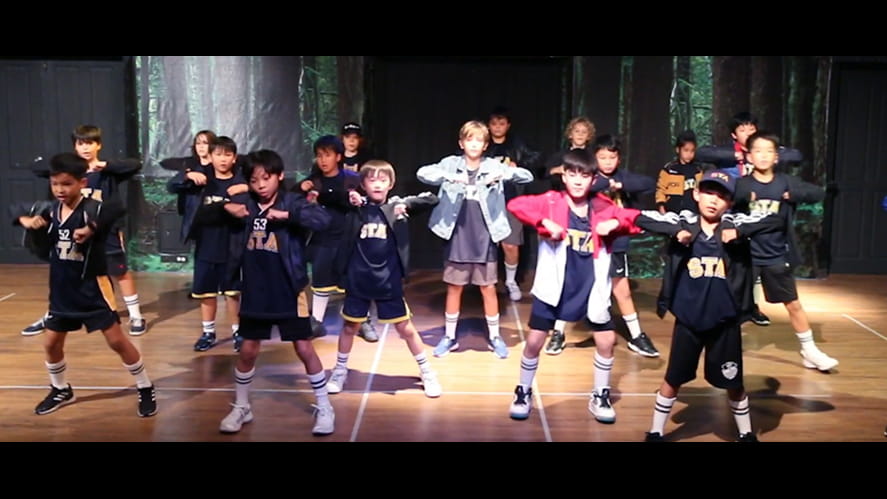We use cookies to improve your online experiences. To learn more and choose your cookies options, please refer to our cookie policy.

Author: Ms Ceris High School Dance Teacher
In my 15 years teaching Dance and as a dancer, I have seen attitudes to boys in dance gradually change, however, the stigma of toxic gender stereotypes still exist in many parts of the world and industry making it difficult for people to accept that dance truly is for everyone. So I want to take a deeper dive into those perceptions, the provision for boys' dance and the opportunity and access to dance at St Andrews.
In August 2019, 300 dancers joined together on the streets of Times Square in New York City, for a ballet class. The flash dance mob came together in response to a segment of Good Morning America when host Lara Spencer laughed out loud at the news that Prince George was taking ballet classes. Her reaction and sarcastic comments both shocked and outraged the entire dance community, with dancers and major companies from all over the world heading to their Instagram accounts to share their anger and disappointment at what was seen as both outright bullying and reinforcement of toxic gender stereotyping (ballet, like all sports, is non-gendered), Lara later publicly apologised and interviewed three men in the industry about their experiences and that can be seen here. Sadly this controversial opinion is still shared by some people, but it is thanks to the dance community that it is always being challenged when situations like this arise
Above Image: Travis Wall Instagram, 300 men and boys flash mob in NYC to support Prince George of England's love of ballet
Provision for Dance in Primary and High schools varies from country to country and even within countries. Some schools strongly support the arts and others do not. At St Andrews, all students in Key Stage 3 (KS3) (Year 7- Year 9) have one lesson of timetabled Dance a week, recognizing the importance of exposure to the art form.
However, not all schools have the same standard of teachers, with their experience in Dance education, the dance industry and even their dance training varying a lot from school to school. To combat this, in the UK many more schools are ensuring their dance department teachers have both industry experience and an excellent understanding of choreographic processes to ensure students are able to develop a range of performance skills and choreographic skills in preparation for GCSE, A-Level and IB. For the perceptions of boys in dance, this exposure to the discipline and its array of styles is vital for all to understand this discipline is not gender-specific. Here at St Andrews, we have excellent provision, with experienced dance teachers, all supported by our leadership team, Nord Anglia and of course our connections with Julliard. This year in the Junior Varsity team we have welcomed more boys and we hope this trend will continue to grow. Moreover, our KS3 lessons are purposefully geared to show equality in gender from the set works we study, the styles we focus on, the dancers and choreographers we learn about and finally the exploratory methods of teaching.
Often the lack of opportunity for boys in dance perpetuates the stereotypes and negative images. However, we are at a turning point with the tides changing and it’s up to us as a community to keep that momentum going. There is a growing awareness that boys should have equal entitlement and access to dance as girls. So often teachers are used to having lots of girls and get stuck in their ways only choreographing for large groups of girls rather than considering the choreographic intent and communicating a theme, idea or narrative. It is the latter approach that we take in KS3 Dance - learning the cultural significance of a style and understanding how to choreograph movement to a given theme or idea. The Juilliard approach is exploratory and allows each dancer to find their own expressive voice and celebrate individuality as well as collaboration and teamwork. We want all dancers at STA to have great body confidence and learn to take their personal obstacles and turn them into opportunities, always appreciating each dancer's own unique style.
I asked our Juilliard dance specialist Hilary Easton (right) to comment and this is what she said...
Our hope at Juilliard is that all genders will feel equally welcome in all dance classes, school performances, and projects. Dance is often dismissed as “girly” or female-oriented, framing that quality as negative. However, in schools this female focus can be a real strength, giving leadership roles to girls, young women, and other students who do not represent traditionally macho characteristics, including students who identify as nonbinary. When Dance is encouraged at schools, a wide range of students is a part of that project, thus contributing to an atmosphere where all students’ talents are showcased and all abilities are honoured.
Traditionally, dance has played a minor or nonexistent role for boys at schools. This has both confirmed and perpetuated a bias against dance that can be seen as a reflection of larger prejudices against that which seems feminine. Conversely, in many schools where dance is honoured as a central part of the curriculum, taught from the earliest years and supported and highlighted throughout, greater parity can be seen between students as well as a general positivity toward all students.
Sources:
Brian Freedman interview - More than Dance
Dance Magazine
Juilliard Creative Classroom
You can learn more about our collaboration with Julliard below: